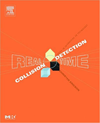Real-Time Collision Detection
 BLURB: Today's sophisticated 3D games, virtual reality applications, and physical
simulators involve rich graphical environments of millions of polygons. In
these worlds, hundreds, perhaps even thousands of detailed animated objects
may be interacting not only with these complex environments but also amongst
themselves. With a typical update rate of 60 frames per second, a minimal
amount of time is available for determining the intersection status of all
objects in the world at a given time in order to maintain a believable simulation.
Real-Time Collision Detection is a comprehensive, in-depth survey of the data
structures and algorithms that make this possible. Taking a practical approach,
the book discusses all the important components of an efficient real-time
collision detection system. Topics covered include object representations,
intersection tests, and distance queries, and the mathematics behind them:
hierarchical and spatial partitioning methods, numerical and geometrical
robustness issues, hardware acceleration methods, and advanced optimization
for modern computer architectures. This book extends and broadens the
discussion of collision detection in Collision Detection in Interactive
3D Environments.
BLURB: Today's sophisticated 3D games, virtual reality applications, and physical
simulators involve rich graphical environments of millions of polygons. In
these worlds, hundreds, perhaps even thousands of detailed animated objects
may be interacting not only with these complex environments but also amongst
themselves. With a typical update rate of 60 frames per second, a minimal
amount of time is available for determining the intersection status of all
objects in the world at a given time in order to maintain a believable simulation.
Real-Time Collision Detection is a comprehensive, in-depth survey of the data
structures and algorithms that make this possible. Taking a practical approach,
the book discusses all the important components of an efficient real-time
collision detection system. Topics covered include object representations,
intersection tests, and distance queries, and the mathematics behind them:
hierarchical and spatial partitioning methods, numerical and geometrical
robustness issues, hardware acceleration methods, and advanced optimization
for modern computer architectures. This book extends and broadens the
discussion of collision detection in Collision Detection in Interactive
3D Environments.
CONTENTS: Introduction, Collision detection design issues, A math and geometry primer, Bounding volumes, Basic primitive tests, Bounding volume hierarchies, Spatial partitioning, BSP tree hierarchies, Convexity-based methods, GPU-assisted collision detection, Numerical robustness, Geometrical robustness, Optimization.
